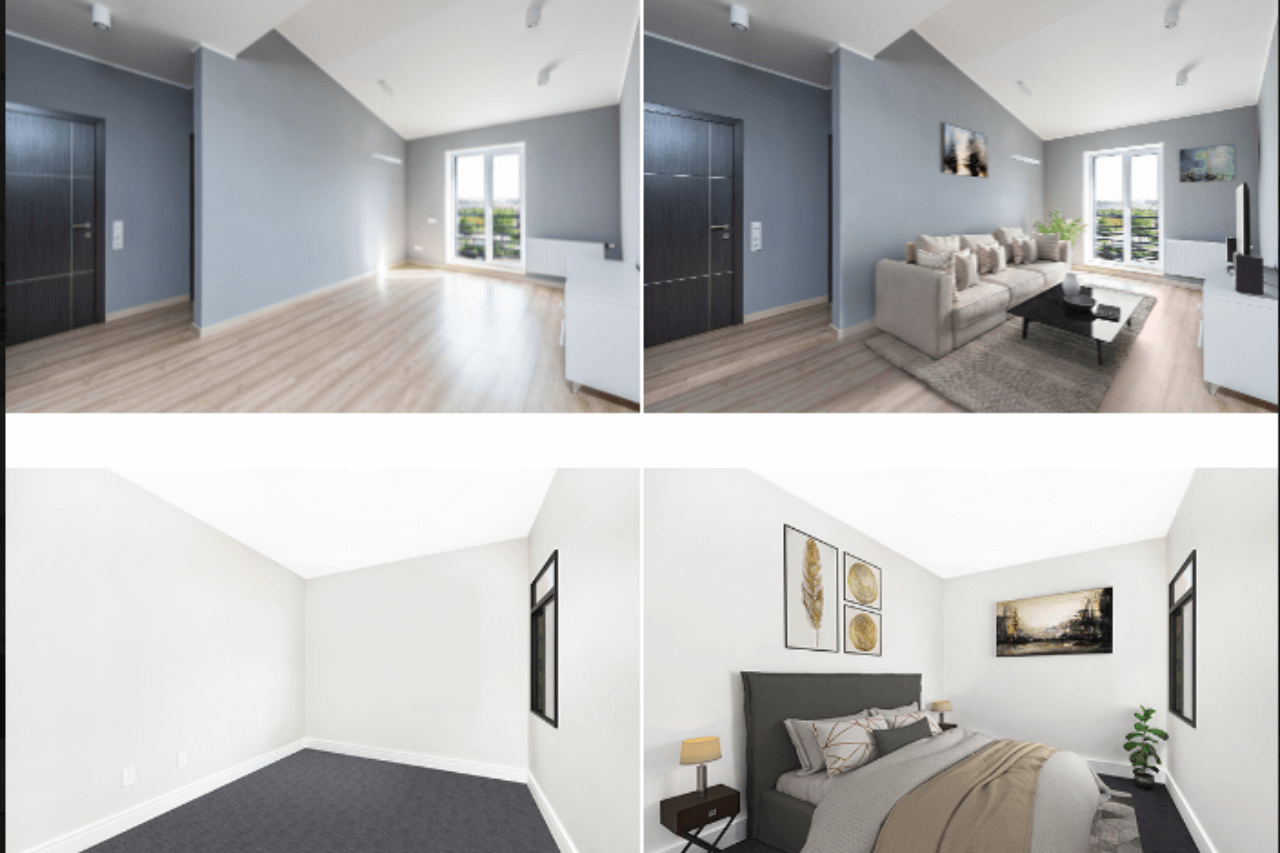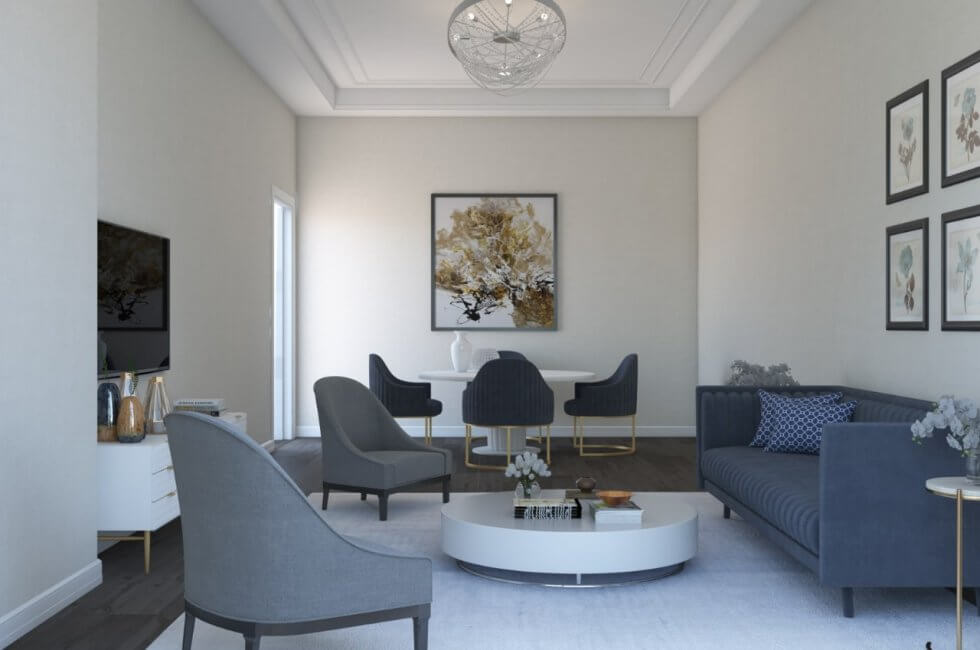From the minimalist elegance of modern apartments to the timeless charm of historic homes, virtual staging transcends the constraints of the physical world, inviting you to explore realms yet to be built and designs yet to be realized. Mainly, virtual staging is applied in 3D architectural visualization and animation space where buildings don't just stand; they dance with elegance, whispering tales of modernity and charm. We can picture walking through a beautifully furnished apartment, complete with exquisite furnishings and a cosy ambience, all before a single piece of furniture is physically placed. It's not just visualization; it's a journey.
In this text, we will explore the wonders of virtual staging in real estate, its benefits, and how it is redefining the real estate landscape, one pixel at a time.
What Does Virtually Staged Mean in Real Estate?
In the realm of real estate, "virtually staged" refers to a cutting-edge technique that harnesses the power of digital technology to enhance property listings. Unlike traditional home staging, where physical furniture and decor are brought into a property, virtual staging is done entirely through computer-generated imagery (CGI). Skilled designers utilize specialized software to digitally furnish and decorate vacant or under-furnished spaces. This process breathes life into empty rooms, allowing potential buyers or renters to envision the full potential and possibilities of the space.Virtually staged photos showcase the property's best features, transforming blank canvases into warm, inviting living areas. It enables real estate professionals to present a property in its best light, catering to diverse tastes and preferences. For instance, a virtually staged living room might feature contemporary furniture and vibrant artwork, while a bedroom could showcase a cosy atmosphere with carefully chosen linens and lighting.
In essence, virtual staging revolutionizes real estate marketing by providing a compelling, immersive experience that bridges the imagination gap between an empty space and a dream home.
Why Virtually Stage Real Estate Properties?
Virtual staging transforms empty properties into appealing, furnished homes, helping potential buyers envision their future spaces. It enhances online listings, attracting more interest and increasing sales potential. By showcasing a property's full potential without physical staging costs, it offers a cost-effective and visually captivating solution, making it a vital tool in modern real estate marketing. Let us dig into detail why it is important to virtually stage a real estate property.
Bringing Imagination to Life
Virtual staging is a creative marvel that harnesses state-of-the-art technology to transform empty, uninspiring spaces into visually captivating dreamscapes. It involves the strategic integration of digital elements, from furniture to decor, into photographs of bare rooms. By digitally enhancing and furnishing these properties, virtual staging enables potential buyers to envision the space's potential. Unlike traditional staging methods, which require the physical placement of furniture and decor, virtual staging is entirely digital.On top of that, it offers a cost-effective and flexible solution for both real estate agents and sellers. This digital alchemy not only breathes life into vacant rooms but also allows buyers to see the possibilities, igniting their imagination and creating a compelling vision of a home they desire.
Learn more about photorealistic rendering techniques and how it works.
Versatility and Cost-effectiveness
Virtual staging's key advantage lies in its cost-effectiveness. Unlike traditional staging, which demands significant financial investments in furniture, movers, and renovations, virtual staging incurs minimal expenses. Sellers are spared the hassle and expenses associated with physical staging, making the process quick and hassle-free. Its adaptability is another highlight. Whether it's a sleek, modern apartment or a vintage home, virtual staging effortlessly caters to diverse architectural styles. It also allows incorporating personal preferences, making it an ideal fit for buyers.Consider a seller with a charming vintage home. Physical staging would mean significant expenses on furniture and decor. Virtual staging, on the other hand, is the epitome of cost-effectiveness. With minimal investment, the vintage home transforms into a visually appealing space online. Whether the buyer prefers a cosy cottage vibe or a more elegant ambience, virtual staging adapts seamlessly. The seller not only saves costs but also attracts a broader audience with personalized virtual presentations.
Creating Emotional Connections
Virtual staging transcends the mere visual presentation; it forges emotional connections between the property and potential buyers. Instead of passively viewing pictures, buyers engage in active imagination. They visualize their future lives within these spaces, imagining the warmth of sunlight flooding the living room, the aroma of culinary adventures in the kitchen, and the promise of serene nights in the bedroom. This emotional engagement becomes a pivotal factor, often tipping the scales towards a sale, as buyers can envisage the property as their future home, complete with their dreams, aspirations, and memories.Take for instance, a couple searching for their first home. Through virtual staging, they virtually step into a modern living room, sunlit and filled with laughter from family gatherings. In the kitchen, they envision shared culinary adventures, and in the basement, they explore a free space to design however they like best. This emotional connection solidifies their decision, turning the virtual space into their dream home.
Addressing Empty Spaces and Outdated Interiors
Empty spaces lack the charm that furnished homes exude, making it challenging to create a lasting impression. Virtual staging expertly tackles this challenge by injecting life into these barren areas, adding virtual furniture and decor. Moreover, outdated interiors can deter potential buyers, but virtual staging acts as a transformative tool. It modernizes and revitalizes these spaces, showcasing their true potential in the form of 3D interior renders.Virtual staging shows even the most outdated or empty properties as inviting, modern, and desirable. When explored in a walkthrough mode, these aesthetically designed spaces broaden their appeal to a wider audience. Here are top 5 reasons for you to invest in 3D rendering services.
Virtual Staging Trends
The future of real estate marketing is intertwined with technological advancements, particularly in the realms of Augmented Reality (AR) and Virtual Reality (VR). These technologies are reshaping how buyers interact with property listings. AR and VR applications enable potential buyers to virtually walk through a staged property, providing an immersive experience directly from their homes. These innovations elevate the virtual staging experience, making it visually engaging and interactive. It allows buyers to explore every nook and cranny of a property before they physically step inside. Undoubtedly, this is revolutionizing the way properties are marketed and experienced.Learn more about how ArchXStudio is the best architectural animation studio.
Conclusion
In 3D architectural visualization, first impressions are everything. Virtual staging not only creates stunning visual representations of properties but also crafts immersive experiences that resonate with buyers on a profound level. It bridges the gap between imagination and reality, turning ordinary listings into extraordinary opportunities. As we move forward, the integration of virtual staging technologies promises a future where every property, regardless of its condition, can be presented in the best possible light, captivating hearts and closing deals in ways we never thought possible. Welcome to the future of real estate marketing – where extraordinary properties find their perfect match through the magic of virtual staging.Author | Mubashrah Rahim

